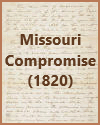 |
| Unit VI: National and Sectional Conflict Maps and Pictures |
|---|
| www.studenthandouts.com ↣ U.S. History ↣ National & Sectional Conflict ↣ Maps & Pictures |
 | ||||||||||
| Missouri Compromise (1820) |
|
Maps and pictures can be invaluable visual aids for American History students studying the national and sectional conflicts of the 1840s and 1850s. Geographic Context: Maps can provide a visual representation of the United States during this period, highlighting the boundaries of states and territories. They can illustrate the geographical distribution of slavery, free states, and territories open to settlement, helping students understand the sectional divide. Expansion of Slavery: Maps can depict the westward expansion of slavery, such as the Missouri compromise line and the extension of slavery into newly acquired territories like Texas. Students can visually track the debates and compromises over the expansion of slavery, including the Kansas-Nebraska Act. Political Divisions: Maps can show the results of presidential elections during this period, highlighting the political divide between the North and the South. They can demonstrate how regional differences influenced voting patterns and the outcomes of key elections. Underground Railroad: Maps can illustrate the routes of the Underground Railroad, a network of secret routes and safe houses used by enslaved people to escape to freedom. They can help students appreciate the efforts of abolitionists and the challenges faced by those seeking freedom. compromises and Legislation: Maps can visually represent the outcomes of key compromises and legislation, such as the compromise of 1850 and the Fugitive Slave Act. Students can see how these measures affected the balance of power between free and slave states. Famous Events: Pictures and illustrations can bring famous events to life, such as the Harpers Ferry raid, the Dred Scott decision, and the Lincoln-Douglas debates. They can provide context and engage students in the visual aspects of history. Portraits of Key Figures: Pictures of key historical figures, including Abraham Lincoln, Frederick Douglass, Harriet Tubman, and John Brown, can help students connect with the individuals who shaped this era. These images can serve as prompts for discussions and research about their contributions. Visualizing Social and Cultural Aspects: Artistic depictions and photographs from the 1840s and 1850s can provide insights into daily life, fashion, and social norms of the period. They can help students understand the cultural context in which these conflicts unfolded. Primary Source Analysis: Maps and pictures can serve as primary sources, allowing students to analyze and interpret historical documents and visual materials. Students can practice critical thinking skills by examining these sources for bias, perspective, and meaning. Incorporating maps and pictures into American History lessons helps students engage with the material on a visual and contextual level. It allows for a multidimensional understanding of the national and sectional conflicts of the 1840s and 1850s, making history more accessible and relatable. |
| www.studenthandouts.com ↣ U.S. History ↣ National & Sectional Conflict ↣ Maps & Pictures |








